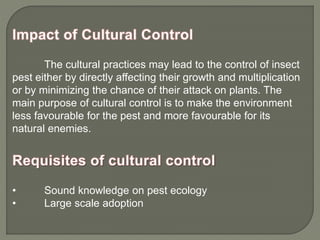What Does Pestwise Mean?
Table of ContentsFascination About PestwisePestwise Can Be Fun For Everyone7 Simple Techniques For Pestwise3 Easy Facts About Pestwise ExplainedThe Facts About Pestwise Revealed9 Simple Techniques For Pestwise4 Easy Facts About Pestwise Shown

Q. Define "integrated parasite monitoring" (IPM) and list numerous feasible control strategies that may be made use of in an IPM strategy. A. Integrated pest management is the combining of appropriate pest control tactics into a solitary strategy to minimize parasites and their damages to an appropriate degree. Bug control methods might include: host resistance, organic control, cultural control, mechanical control, cleanliness, and chemical (chemical) control.
Not known Incorrect Statements About Pestwise
What can you do to keep the insects you are attempting to regulate from becoming resistant to the chemicals you make use of? A. Pest resistance can be minimized by utilizing incorporated parasite management and rotating the types of chemicals made use of.
Parasites are an essential risk to the farming service, and incorporated parasite monitoring helps growers address and reduce these dangers. Integrated bug administration makes use of numerous approaches in facility, thus being a more effective solution to the issue. Termite Control. Particularly, getting rid of aggressive chemical techniques enables lessening injury to people and the atmosphere by utilizing natural and safer choices rather
The 8-Minute Rule for Pestwise
The objective of incorporated insect management is to decrease this damage and control acceptable problem levels rather than remove all undesirable populations. This is why it is vital to comprehend what measures are warranted in each case and usage aggressive ones just when other incorporated management strategies don't function. Integrated management minimizes the unfavorable consequences of a non-IPM technique, and the main advantages of IPM Benefits of IPM.
A right understanding of the infestation extent figures out if the problem must be addressed. are the following components of an IPM program since it is necessary to understand if the organisms make possible threats and pick the incorporated administration choices or the specific pesticide usage. intend to decrease problems by using different agronomic methods.
Pestwise Fundamentals Explained
Integrated management options in an IPM program start with more secure to extra aggressive ones. The above-mentioned incorporated monitoring facets aid comprehend exactly how to plan and implement an IPM program action by action: Screen your crops routinely.

To name a few, IPM social approaches consist of the adhering to area monitoring techniques: soil Get More Information treatment; selection of suitable plants; crop rotation; interplanting or strip chopping; option of growing days; weed control; use catch plants. Beneficial dirt problems quicken plant development, and strenuous plants are a lot more resistant to invasions. Termite Control. In incorporated insect monitoring, dirt screening aids recognize if the area is appropriate for the production of this or that crop, and after that use the lacking nutrients to guarantee plant healthy growth
The Main Principles Of Pestwise
No-till techniques assistance stop soil erosion, contributing to lasting farming. When tilling is required, it is advised to conduct it in the loss to expose them to all-natural enemies and extreme weather. Healthy and balanced seedlings and seeds determine effective crop growth, so it is necessary to choose pest-free growing product with solid roots.
Thus, to name a few applications, crop turning can be efficiently utilized as an integrated pest management method. Vermin spread slower if rows of different crop types separate their host plants in intercropping or strip chopping, which is likewise made use of in the incorporated pest management system. Conversely, problems increase when plants of the same crop type or household grow together.
, as well as tomatoes. Planting catch plants in spots is an additional choice for IPM intercropping. This integrated pest management method recommends drawing in pests to specific plants and after that managing them with chemical or mechanical techniques.
Fascination About Pestwise
Obstacles are common instances of physical IPM approaches. Let's take a closer look at them. Getting rid of or picking parasites out by hand is a time and labor-consuming option that is extensively applied in integrated monitoring and natural farming. Mature insects or their eggs and larvae are collected by hand and ruined.

Division of Plant Sciences. This incorporated monitoring approach implies a typical means of destroying insects by killers, parasitoids, virus, and various other organic control agents (aka antagonistic organisms). The duty of biological control in IPM is to.
Some Of Pestwise
With time, their populace transformed out to be a genuine annoyance to farmers together with native kangaroos or dingoes. The cane toad is another case highlighting incorporated biological control failing in this respect when it declined to search the target species and became a parasite itself. Parasitoids develop on or within their hosts to eventually eliminate them after developing.